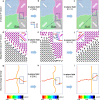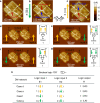Ferroelectric domain-wall logic units
- PMID: 35668083
- PMCID: PMC9170692
- DOI: 10.1038/s41467-022-30983-4
Ferroelectric domain-wall logic units
Abstract
The electronic conductivities of ferroelectric domain walls have been extensively explored over the past decade for potential nanoelectronic applications. However, the realization of logic devices based on ferroelectric domain walls requires reliable and flexible control of the domain-wall configuration and conduction path. Here, we demonstrate electric-field-controlled stable and repeatable on-and-off switching of conductive domain walls within topologically confined vertex domains naturally formed in self-assembled ferroelectric nano-islands. Using a combination of piezoresponse force microscopy, conductive atomic force microscopy, and phase-field simulations, we show that on-off switching is accomplished through reversible transformations between charged and neutral domain walls via electric-field-controlled domain-wall reconfiguration. By analogy to logic processing, we propose programmable logic gates (such as NOT, OR, AND and their derivatives) and logic circuits (such as fan-out) based on reconfigurable conductive domain walls. Our work might provide a potentially viable platform for programmable all-electric logic based on a ferroelectric domain-wall network with low energy consumption.
© 2022. The Author(s).
Conflict of interest statement
The authors declare no competing interests.
Figures





References
-
- Catalan G, Seidel J, Ramesh R, Scott JF. Domain wall nanoelectronics. Rev. Mod. Phys. 2012;84:119–156. doi: 10.1103/RevModPhys.84.119. - DOI
-
- Meier D, Selbach SM. Ferroelectric domain walls for nanotechnology. Nat. Rev. Mater. 2022;7:157–173. doi: 10.1038/s41578-021-00375-z. - DOI
-
- Yang S-H, Naaman R, Paltiel Y, Parkin SSP. Chiral spintronics. Nat. Rev. Phys. 2021;3:328–343. doi: 10.1038/s42254-021-00302-9. - DOI
-
- Raymenants E, et al. Nanoscale domain wall devices with magnetic tunnel junction read and write. Nat. Electron. 2021;4:392–398. doi: 10.1038/s41928-021-00593-x. - DOI
-
- Li R, et al. A spin–orbit torque device for sensing three-dimensional magnetic fields. Nat. Electron. 2021;4:179–184. doi: 10.1038/s41928-021-00542-8. - DOI
LinkOut - more resources
Full Text Sources
Miscellaneous

